Performance of Fly Ash Geopolymer Concrete Incorporating Bamboo Ash at Elevated Temperature
Abstract
:1. Introduction
2. Experimentation
2.1. Materials
2.1.1. Binder
2.1.2. Aggregates
2.1.3. Alkaline Solution
2.1.4. Superplasticizer
2.2. Mix Proportions
2.3. Flow Table Test
2.4. Compressive Strength Test
2.5. Testing Procedures
2.5.1. X-ray Fluorescence (XRF)
2.5.2. X-ray Diffraction (XRD)
2.5.3. Particle Size Analysis (PSA)
2.5.4. Scanning Electron Microscopy (SEM)
2.5.5. Ultrasonic Pulse Velocity (UPV) Test
2.5.6. Fire Endurance Test
3. Results and Discussion
3.1. Characterization of the Binder
3.1.1. X-ray Fluorescence (XRF)
3.1.2. X-ray Diffraction (XRD)
3.1.3. Particle Size Analysis
3.1.4. Scanning Electron Microscopy (SEM) Analysis
3.2. Appropriate Mix Proportion
3.2.1. Workability
3.2.2. Compressive Strength
3.3. Fire Endurance Test
3.3.1. Cooling Effect on the Physical Appearance of the Concrete
3.3.2. Residual Compressive Strength
3.3.3. Ultrasonic Pulse Velocity (UPV) Value after Exposure
3.3.4. Weight Loss of Concrete
4. Conclusions
- SEM analysis shows a rectangular shape of bamboo ash and it is believed that it can hold the paste together and help to provide resistance at high temperatures.
- A 5% addition of bamboo ash in 95% fly ash provided better compressive strength after a short period of time i.e., 7 days of curing, compared to the control sample.
- A light grey color was observed for air cooling (AC) at 600 °C with a rough surface and cracks that appeared in Csample during water cooling (WC), whereas there were no cracks in Asample.
- Csample and Asample gained approximately 36% and 39% residual compressive strength at 200 °C of exposure, respectively, whereas losses of approximately 62% and 41% from 400 °C to 800 °C, respectively, were found after using the air cooling regime.
- Asample exhibited the highest residual compressive strength at 800 °C of exposure compared to Csample for the AC and WC regimes.
- UPV values for both types of samples increased tremendously at 200 °C of exposure, which was concluded to be good in terms of concrete quality. The UPV values tended to decrease from 400 °C to 800 °C of concrete exposure. A greater loss was found at 800 °C of exposure and it led to a change in the stiffness and mechanical properties of geopolymer concrete.
- Asample shows a high confidence level and the best fitted value compared to Csample in UPV vs. weight loss results, which reveals that the velocity of heat passing through the concrete is slower.
Author Contributions
Acknowledgments
Conflicts of Interest
References
- Rajamane, N.P.; Nataraja, M.C.; Lakshmanan, N.; Dattatreya, J.K.; Sabitha, D. Sulphuric acid resistant ecofriendly concrete from geopolymerisation of blast furnace slag. Indian J. Eng. Mater. Sci. 2012, 19, 357–367. [Google Scholar]
- Venkata, R.V.; Mahindrakar, A.B. Impact of aggressive environment on concrete—A review. Int. J. Civ. Eng. Technol. 2017, 8, 777–788. [Google Scholar]
- Duxson, P.; Provis, J.L.; Lukey, G.C.; van Deventer, J.S.J. The role of inorganic polymer technology in the development of green concrete. Cem. Concr. Res. 2007, 37, 1590–1597. [Google Scholar] [CrossRef]
- Davidovits, J. Geopolymer Chemistry and Applicatons, 3rd ed.; Institut Géopolymère: Saint-Quentin, France, 2011; Volume 9, p. 552. [Google Scholar]
- Rangan, B.V. Upcycling Fly Ash into Geopolymer Concrete Products. Int. J. Adv. Str. Geotech Eng. 2014, 3, 349–353. [Google Scholar]
- Wallah, S.E.; Rangan, B.V. Low Calcium Fly Ash Based Geopolymer Concrete: Long Term Properties. Ph.D. Thesis, Curtin University, Perth, Australia, 2006. [Google Scholar]
- Bakharev, T. Geopolymeric materials prepared using Class F fly ash and elevated temperature curing. Cem. Concr. Res. 2005, 35, 1224–1232. [Google Scholar] [CrossRef]
- Ul Haq, E.; Kunjalukkal Padmanabhan, S.; Licciulli, A. Synthesis and characteristics of fly ash and bottom ash based geopolymers—A comparative study. Ceram. Int. 2014, 40, 2965–2971. [Google Scholar] [CrossRef]
- Cheng, T.W.; Chiu, J.P. Fire-resistant geopolymer produce by granulated blast furnace slag. Min. Eng. 2003, 16, 205–210. [Google Scholar] [CrossRef]
- Muhammad, N. Effect of Heat Curing Temperatures on Fly Ash-Based Geopolymer Concrete. Int. J. Eng. Technol. 2019, 8, 15–19. [Google Scholar]
- Hardjito, D.; Rangan, B.V. Development and Properties of Low Calcium Fly Ash Based Geopolymer Concrete; Curtin Research Publications: Perth, Australia, 2005; Volume 8, pp. 10–103. [Google Scholar]
- Nuruddin, M.F.; Demie, S.; Shafiq, N. Effect of mix composition on workability and compressive strength of self-compacting geopolymer concrete. Can. J. Civ. Eng. 2011, 38, 1196–1203. [Google Scholar] [CrossRef]
- Azreen, M.A.; Hussin, M.W.; Nor Hasanah, A.S.L.; Mostafa, S. Effect of ceramic aggregate on high strength multi blended ash geopolymer mortar. J. Teknol. 2015, 16, 33–36. [Google Scholar]
- Abdul Awal, A.S.M.; Abubakar, S.I. Properties of Concrete Containing High Volume Palm Oil. Malays. J. Civ. Eng. 2011, 2, 54–66. [Google Scholar]
- Yong, M.; Liu, J.; Chua, C.P.; Alengaram, U.J.; Jumaat, M.Z. Utilization of Palm Oil Fuel Ash as Binder in Lightweight Oil Palm Shell Geopolymer Concrete. Adv. Mater. Sci. Technol. 2014, 2014, 610274. [Google Scholar]
- Ahmad, M.H.; Omar, R.C.; Malek, M.A.; Md Noor, N.; Thiruselvem, S. Compressive Strength of Palm Oil Fuel Ash Concrete. In Proceedings of the International Conference on Construction and Building Technology, Kuala Lumpur, Malaysia, 16–20 June 2008; Volume 27, pp. 297–306. [Google Scholar]
- Habeeb, G.A.; Mahmud, H.B. Study on Properties of Rice Husk Ash and Its Use as Cement Replacement. Mater. Res. 2010, 13, 185–190. [Google Scholar] [CrossRef]
- Kartini, K. Rice Husk Ash-Pozzolanic Material for Sustainability. Int. J. Appl. Sci. Technol. 2011, 1, 169–178. [Google Scholar]
- Kawabata, C.Y.; Junior, H.S.; Sousa-coutinho, J. Rice Husk Ash derived Waste Materials as Partial Cement Replacement in Lighweight Concrete. Agric. Eng. 2012, 36, 26–31. [Google Scholar]
- Ranjbar, N.; Mehrali, M.; Alengaram, U.J.; Metselaar, H.S.C.; Jumaat, M.Z. Compressive strength and microstructural analysis of fly ash/palm oil fuel ash based geopolymer mortar under elevated temperatures. Constr. Build. Mater. 2014, 65, 114–121. [Google Scholar] [CrossRef]
- Ranjbar, N.; Kuenzel, C. Influence of preheating of fly ash precursors to produce geopolymers. J. Am. Ceram. Soc. 2017, 100, 3165–3174. [Google Scholar] [CrossRef]
- Guan, M. Manual for Bamboo Charcoal Production and Utilization; Bamboo Engineering Research Centre (BERC): Nanjing, China, 2004; Volume 4, pp. 1–24. [Google Scholar]
- Nordahlia, A.S.; Anwar, U.M.K.; Hamdan, H.; Latif, M.A.; Mahanim, S.M.A. Anatomical, physical and strength properties of Shizostachyum brachycladum ( Buluh lemang ). J. Bamboo Ratt. 2010, 10, 111–122. [Google Scholar]
- Araminta, B.; Octavia, F.A.; Hadipraja, M.; Isnaeniah, S.; Viriani, V. Lemang (Rice Bamboo) as representative of typical malay food in Indonesia. J. Ethic Foods 2017, 4, 3–7. [Google Scholar]
- ASTM C127-15. Standard Test Method for Density. In Relative Density (Specific Gravity), and Absorption of Coarse Aggregates; ASTM International: West Conshohocken, PA, USA, 2015. [Google Scholar]
- ASTM C128-15. Standard Test Method for Relative Density (Specific Gravity) and Absorption of Fine Aggregate; ASTM International: West Conshohocken, PA, USA, 2015. [Google Scholar]
- ASTM C29/C29M-17a. Standard Test Method for Bulk Density (“Unit Weight”) and Voids in Aggregate; ASTM International: West Conshohocken, PA, USA, 2017. [Google Scholar]
- BS EN 933-1. Tests for Geometrical Properties of Aggregates. Determination of Particle Size Distribution; Sieving method; British Stanards Institution: London, UK, 2012. [Google Scholar]
- Behzad, N.; Jay, S. Effect of different superplasticizers and activator combinationson workability and strength of fly ash based geopolymer. Mater. Des. 2014, 57, 667–672. [Google Scholar]
- Huseien, G.F.; Ismail, M.; Tahir, M.; Mirza, J.; Hussein, A.; Khalid, N.H.; Sarbini, N.N. Effect of Binder to Fine Aggregate Content on Performance of Sustainable Alkali Activated Mortars Incorporating Solid Waste Materials. Chem. Eng. Trans. 2018, 63, 667–672. [Google Scholar] [CrossRef]
- Shen, P.; Lu, L.; He, Y.; Wang, F.; Lu, J.; Zheng, H.; Hu, S. Investigation on expansion effect of the expansive agents in ultra-high performance concrete. Cem. Concr. Compos. 2020, 105, 103425. [Google Scholar] [CrossRef]
- Zhang, X.; Zhao, S.; Liu, Z.; Wang, F. Utilization of steel slag in ultra-high performance concrete with enhanced eco-friendliness. Constr. Build. Mater. 2019, 214, 28–36. [Google Scholar] [CrossRef]
- Liang, X.; Wu, C.; Yang, Y.; Wu, C.; Li, Z. Coupled effect of temperature and impact loading on tensile strength of ultra-high performance fibre reinforced concrete. Compos. Struct. 2019, 229, 111432. [Google Scholar] [CrossRef]
- Kim, S.; Yoo, D.Y.; Kim, M.-J.; Banthia, N. Self-healing capability of ultra-high-performance fiber-reinforced concrete after exposure to cryogenic temperature. Cem. Concr. Compos. 2019, 104, 103335. [Google Scholar] [CrossRef]
- Turker, K.; Hasgul, U.; Birol, T.; Yavas, A.; Yazici, H. Hybrid fiber use on flexural behavior of ultra high performance fiber reinforced concrete beams. Compos. Struct. 2019, 229, 111400. [Google Scholar] [CrossRef]
- Huseien, G.F.; Sam, A.R.M.; Shah, K.W.; Mirza, J.; Tahir, M.M. Evaluation of alkali-activated mortars containing high volume waste ceramic powder and fly ash replacing GBFS. Constr. Build. Mater. 2019, 210, 78–92. [Google Scholar] [CrossRef]
- ASTM C1437-15. Standard Test Method for Flow of Hydraulic Cement Mortar; ASTM International: West Conshohocken, PA, USA, 2015. [Google Scholar]
- ASTM C 109-16. Standard Test Method for Compressive Strength of Hydraulic Cement Mortars; ASTM International: West Conshohocken, PA, USA, 2016. [Google Scholar]
- BS EN 12504-4. Testing Concrete. Determination of Ultrasonic Pulse Velocity; British Stanards Institution: London, UK, 2004. [Google Scholar]
- ASTM E119-12a. Standard Test Methods for Fire Tests of Building Construction and Materials; ASTM International: West Conshohocken, PA, USA, 2012. [Google Scholar]
- Luo, X.; Sun, W.; Chan, S.Y.N. Effect of heating and cooling regimes on residual strength and microstructure of normal strength and high-performance concrete. Cem. Concr. Res. 2000, 30, 379–383. [Google Scholar] [CrossRef]
- Peng, G.; Bian, S.; Guo, Z.; Zhao, J.; Peng, X.; Jiang, Y. Effect of thermal shock due to rapid cooling on residual mechanical properties of fiber concrete exposed to high temperatures. Constr. Build. Mater. 2008, 22, 948–955. [Google Scholar] [CrossRef]
- Kuenzel, C.; Ranjbar, N. Dissolution mechanism of fly ash to quantify the reactive aluminosilicates in geopolymerisation. Resour. Conserv. Recycl. 2019, 150, 104421. [Google Scholar] [CrossRef]
- Davidovits, J. Geopolymer Cement a Review; Technical Paper #21 for Geopolymer Science and Technics; Geopolymer Institute Library: Saint-Quentin, France, 2013. [Google Scholar]
- Sukumar, A.; John, E. Fiber addition and its effect on concrete strength. Int. J. Innov. Res. Adv. Eng. (IJIRAE) 2014, 1, 144–149. [Google Scholar]
- Kong, D.L.Y.; Sanjayan, J.G. Effect of elevated temperatures on geopolymer paste, mortar and concrete. Cem. Concr. Res. 2010, 40, 334–339. [Google Scholar] [CrossRef]
- Neville, A.M. Properties of Concrete, 5th ed.; Pearson Education Limited: Edinburgh Gate, UK, 2011. [Google Scholar]
- Farhad, A.; Zohaib, A. Properties of Ambient-Cured Normal and Heavyweight Geopolymer Concrete Exposed to High Temperatures. Materials 2019, 5, 740. [Google Scholar]

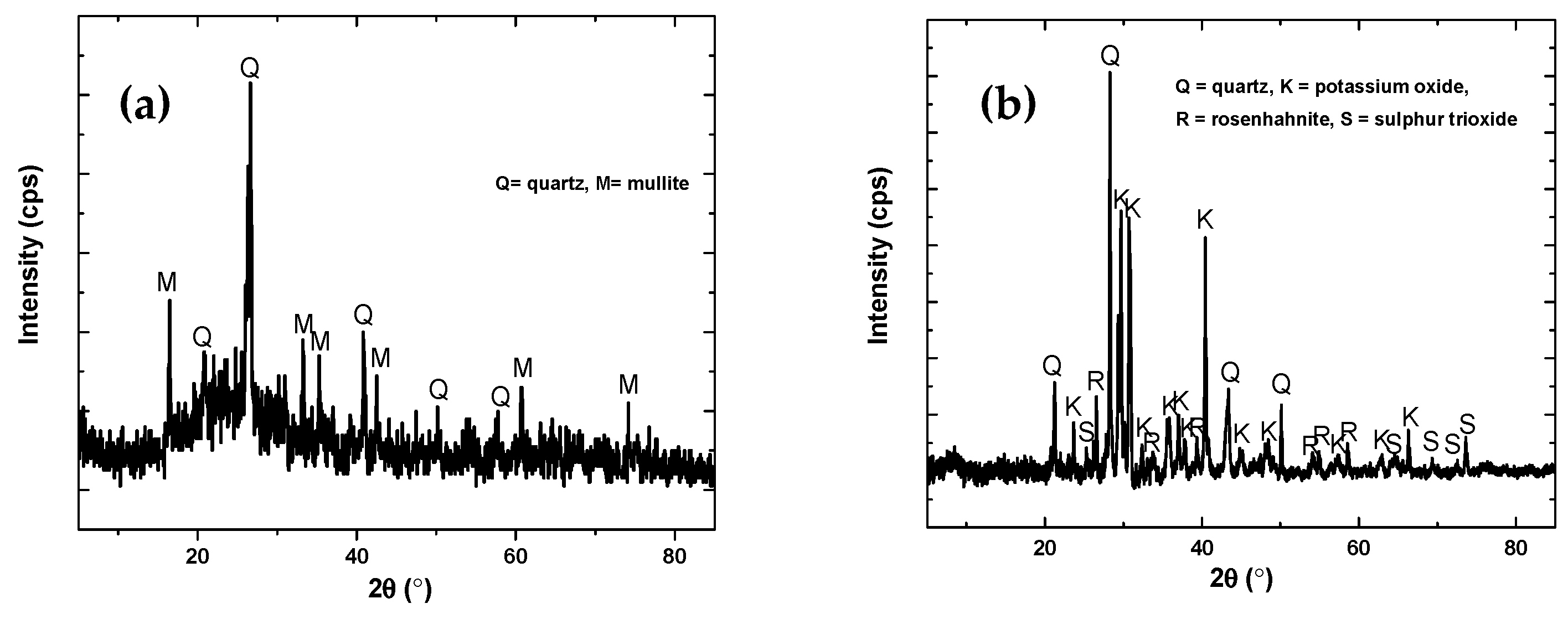
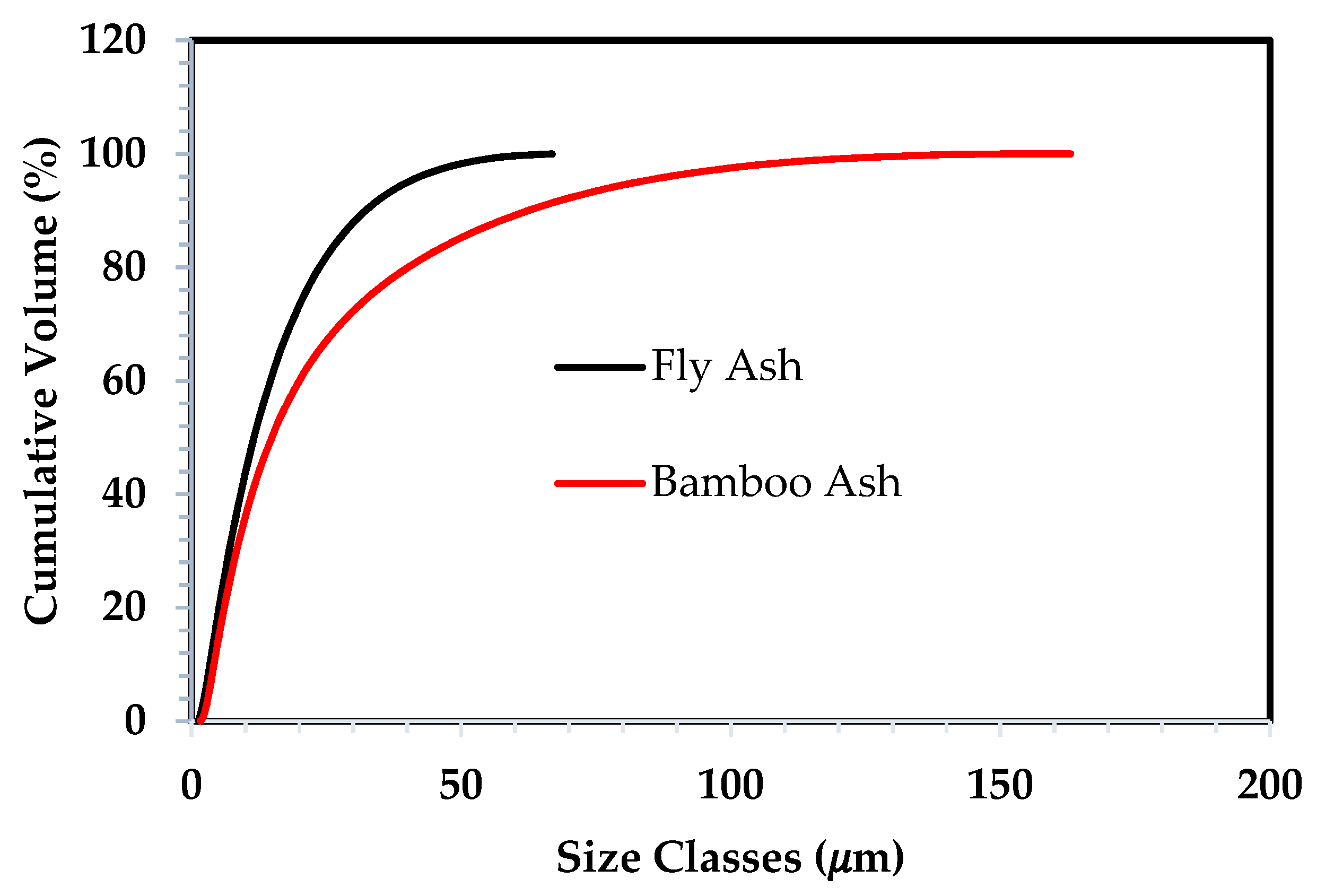
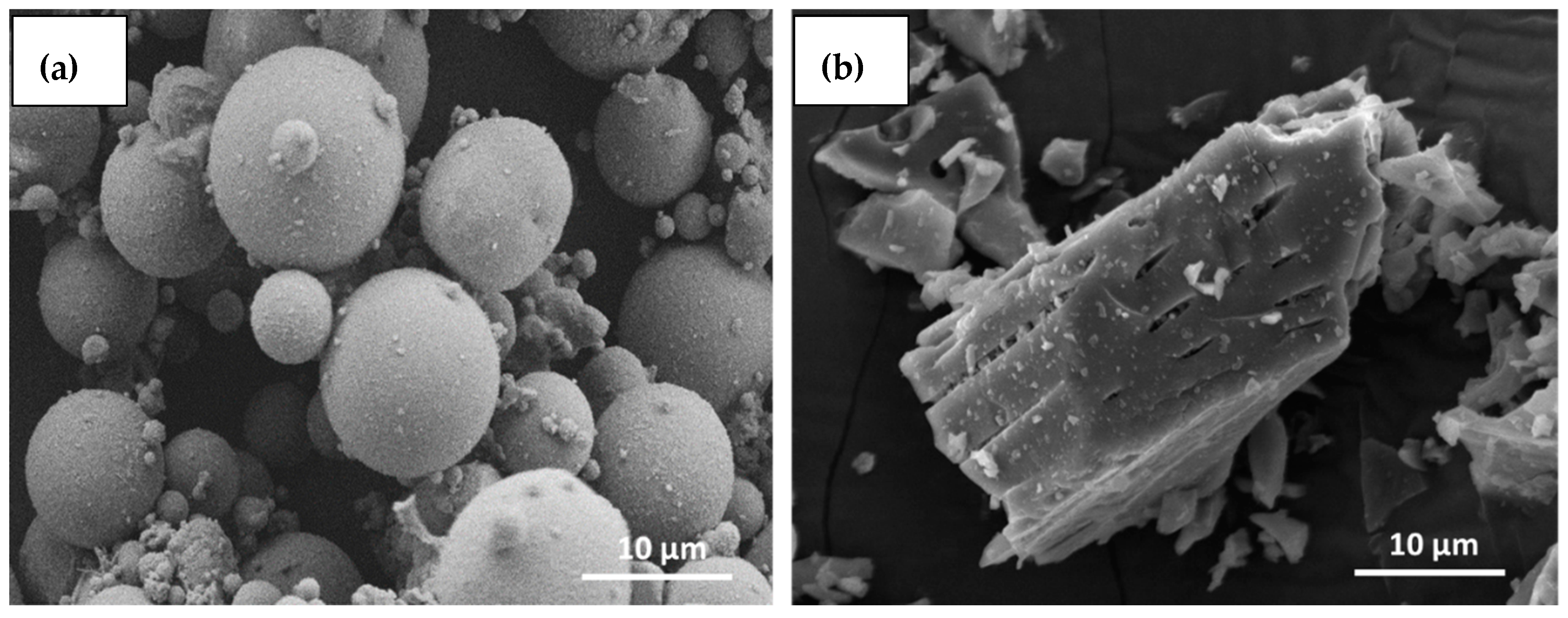
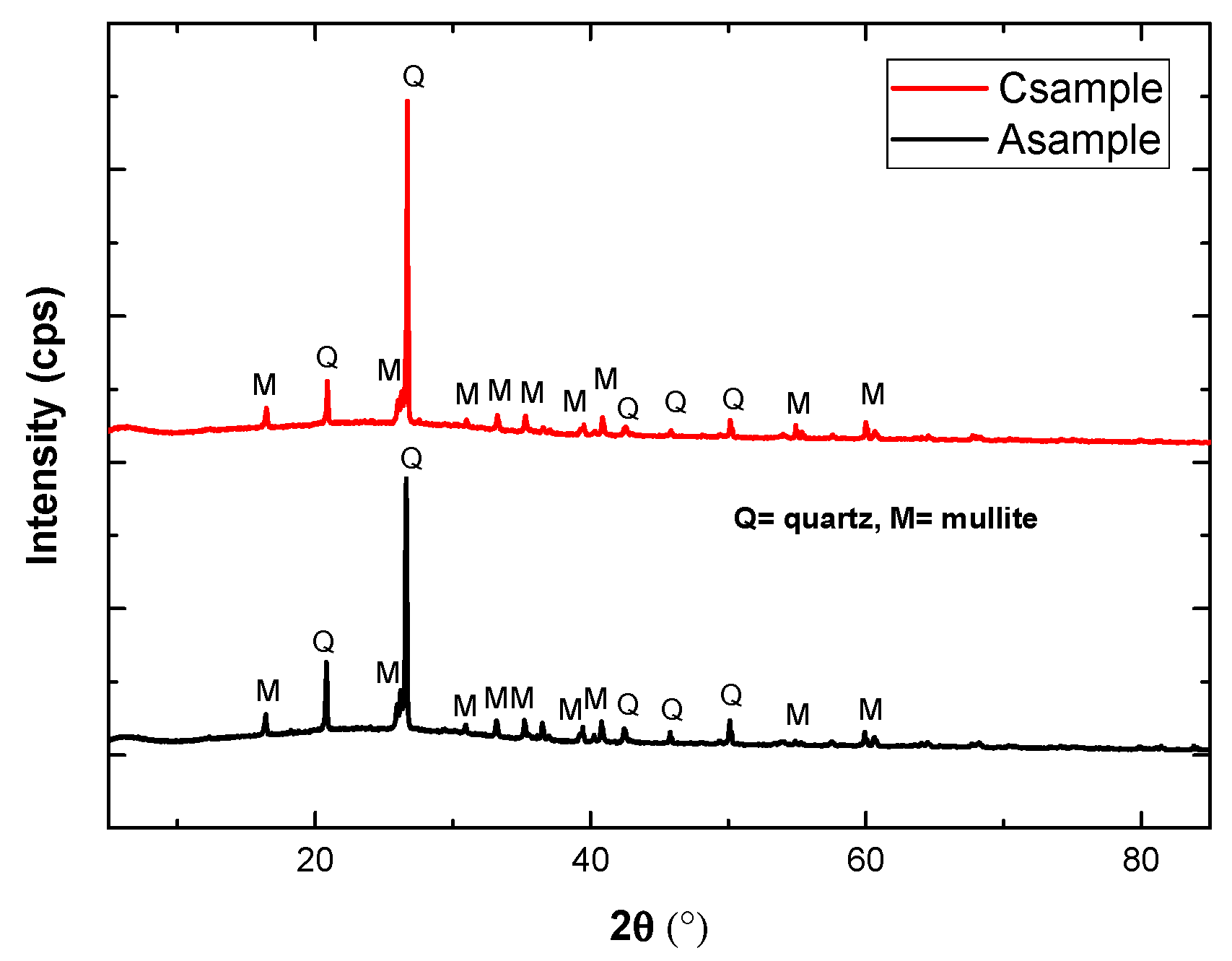
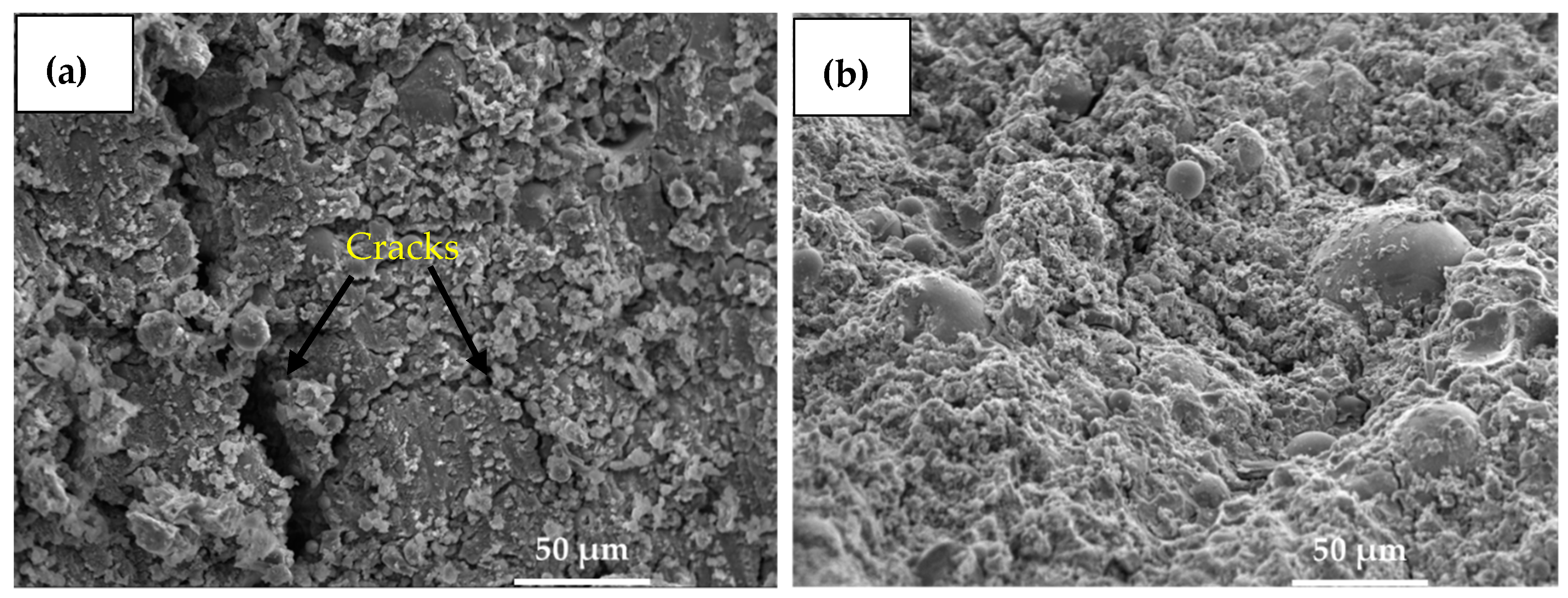

| No. | Fly Ash (kg/m3) | Bamboo Ash (kg/m3) | NaOH (kg/m3) | Na2SiO3 (kg/m3) | Activator/Binder | Water (kg/m3) |
|---|---|---|---|---|---|---|
| 1. | 1215 | – | 138.86 | 347.14 | 0.40 | 63.18 |
| 2. | 1154 | 61(5%) | 138.60 | 347.14 | 63.18 | |
| 3. | 1093 | 122(10%) | 138.60 | 347.14 | 63.18 | |
| 4. | 1033 | 182(15%) | 138.60 | 347.14 | 63.18 | |
| 5. | 972 | 243(20%) | 138.86 | 347.14 | 63.18 | |
| 6. | 729 | 486(40%) | 138.86 | 347.14 | 63.18 | |
| 7. | 486 | 729(60%) | 138.86 | 347.14 | 63.18 | |
| 8. | 243 | 972(80%) | 138.86 | 347.14 | 63.18 | |
| 9. | – | 1215(100%) | 138.86 | 347.14 | 63.18 |
| No | Flow Diameter | Workability |
|---|---|---|
| 1 | Above 250 mm | Very High |
| 2 | 180 mm to 250 mm | High |
| 3 | 150 mm to 180 mm | Moderate |
| 4 | 150 mm to 120 mm | Stiff |
| 5 | Below 120 mm | Very Stiff |
| Chemical Compounds | BA | FA |
|---|---|---|
| Silica (SiO2) | 35.2 | 55.92 |
| Alumina (Al2O3) | – | 28.8 |
| Calcium oxide (CaO) | 13.5 | 5.16 |
| Potassium oxide (K2O) | 33.1 | 0.94 |
| Sulfur trioxide (SO3) | 8.3 | – |
| Iron oxide (Fe2O3) | 1.0 | 3.67 |
| Manganese oxide (MnO) | 3.1 | – |
| Phosphorus pentaoxide (P2O5) | – | 0.69 |
| Titanium oxide (TiO2) | – | 2.04 |
| Magnesium oxide (MgO) | – | 1.48 |
| Loss of Ignition (LOI) | 5.8 | 1.3 |
| Sample | Activator to Binder Ratio | Slump Value (mm) | Average (mm) | Standard Deviation (mm) | Slump Loss (mm) | ||
|---|---|---|---|---|---|---|---|
| Sample 1 | Sample 2 | Sample 3 | |||||
| 100% FA (Csample) | 0.40 | 140 | 142 | 138 | 140 | 2.00 | 0 |
| 0.45 | 202 | 187 | 190 | 193 | 7.94 | 0 | |
| 0.50 | 225 | 220 | 215 | 220 | 5.00 | 0 | |
| 5% BA+ 95% FA (Asample) | 0.40 | 139 | 126 | 125 | 130 | 7.81 | 10 |
| 0.45 | 185 | 183 | 187 | 185 | 2.00 | 8 | |
| 0.50 | 219 | 203 | 208 | 210 | 8.19 | 10 | |
| Sample ID | Curing Time (Days) | Compressive Strength (MPa) | Average (MPa) | Standard Deviation (MPa) | ||
|---|---|---|---|---|---|---|
| Sample 1 | Sample 2 | Sample 3 | ||||
| 100FA | 7 | 16.31 | 16.19 | 15.96 | 16.15 | 0.18 |
| 14 | 32.48 | 33.76 | 33.93 | 33.39 | 0.79 | |
| 28 | 42.81 | 42.53 | 41.06 | 42.13 | 0.94 | |
| 5BA:95FA | 7 | 18.67 | 19.1 | 19.05 | 18.94 | 0.24 |
| 14 | 31.01 | 30.34 | 32.14 | 31.16 | 0.91 | |
| 28 | 42.56 | 41.03 | 39.96 | 41.18 | 1.31 | |
| 10BA:90FA | 7 | 15.87 | 16.03 | 16.21 | 16.04 | 0.17 |
| 14 | 24.52 | 25.1 | 24.86 | 24.83 | 0.29 | |
| 28 | 39.44 | 40.12 | 39.68 | 39.75 | 0.34 | |
| 15BA:85FA | 7 | 13.1 | 14.05 | 13.85 | 13.67 | 0.50 |
| 14 | 22.66 | 23.81 | 23.06 | 23.18 | 0.58 | |
| 28 | 32.28 | 33.14 | 33.56 | 32.99 | 0.65 | |
| 20BA:80FA | 7 | 11.01 | 12.56 | 12.14 | 11.90 | 0.80 |
| 14 | 21.41 | 22.35 | 21.03 | 21.60 | 0.68 | |
| 28 | 34.8 | 35.24 | 34.78 | 34.94 | 0.26 | |
| 40BA:60FA | 7 | 7.5 | 6.96 | 8.5 | 7.65 | 0.78 |
| 14 | 6.86 | 8.96 | 7.48 | 7.77 | 1.08 | |
| 28 | 9.21 | 10.04 | 9.86 | 9.70 | 0.44 | |
| 60BA:40FA | 7 | 2.35 | 2.37 | 2.5 | 2.41 | 0.08 |
| 14 | 5.12 | 5.74 | 6.01 | 5.62 | 0.46 | |
| 28 | 7.03 | 7.56 | 8.05 | 7.55 | 0.51 | |
| 80BA:20FA | 7 | 0 | 0 | 0 | 0 | 0.00 |
| 14 | 1.06 | 1.24 | 1.33 | 1.21 | 0.14 | |
| 28 | 2.44 | 2.22 | 2.29 | 2.32 | 0.11 | |
| 100BA | 7 | 0 | 0 | 0 | 0 | 0.00 |
| 14 | 0 | 0 | 0 | 0 | 0.00 | |
| 28 | 0 | 0 | 0 | 0 | 0.00 | |
| Parameters | Temperature (°C) | |||||||
|---|---|---|---|---|---|---|---|---|
| 200 | 400 | 600 | 800 | |||||
| Type of cooling | AC | WC | AC | WC | AC | WC | AC | WC |
| Color | Grey | Grey | Grey | Grey | Light grey | Yellowish grey | Light grey | Grey |
| Texture | Smooth | Smooth | Smooth | Smooth | Rough | Crack | Fragmentation | Fragmentation |
| Parameters | Temperature (°C) | |||||||
|---|---|---|---|---|---|---|---|---|
| 200 | 400 | 600 | 800 | |||||
| Type of cooling | AC | WC | AC | WC | AC | WC | AC | WC |
| Color | Grey | Grey | Grey | Grey | Light grey | Light grey | Grey | Grey |
| Texture | Smooth | Smooth | Smooth | Smooth | Rough | Rough | Rough | Fragmentation |
| Temperature (°C) | Residual Compressive Strength (MPa) | |||
|---|---|---|---|---|
| Csample (100% FA) | Asample (95% FA + 5% BA) | |||
| AC | WC | AC | WC | |
| 27 | 42.6 | 42.8 | 41.1 | 41.5 |
| 200 | 57.93 | 56.10 | 57.28 | 55.82 |
| 400 | 25.14 | 24.43 | 24.69 | 22.48 |
| 600 | 15.40 | 14.70 | 15.12 | 14.89 |
| 800 | 9.47 | 8.54 | 14.51 | 14.19 |
| Temperature (°C) | UPV (m/s) | |||
|---|---|---|---|---|
| Csample | Asample | |||
| AC | WC | AC | WC | |
| 27 | 3854 | 3850 | 3810 | 3802 |
| 200 | 4451 | 4417 | 4438 | 4394 |
| 400 | 3340 | 3314 | 3320 | 3191 |
| 600 | 2241 | 2210 | 2235 | 2140 |
| 800 | 1240 | 1360 | 2180 | 2087 |
| UPV (m/s) | Quality of Concrete |
|---|---|
| >4500 | Excellent |
| 3500–4500 | Good |
| 3000–3500 | Doubtful |
| 2000–3000 | Poor |
| <2000 | Very Poor |
| Sample | Temperature (%) | Type of Cooling | Weight Loss (%) |
|---|---|---|---|
| Csample | 200 | AC | 2.41 |
| WC | 1.19 | ||
| 400 | AC | 8.9 | |
| WC | 6.38 | ||
| 600 | AC | 11.96 | |
| WC | 10.83 | ||
| 800 | AC | 12.3 | |
| WC | 10.79 | ||
| Asample | 200 | AC | 2.89 |
| WC | 1.62 | ||
| 400 | AC | 9.1 | |
| WC | 6.65 | ||
| 600 | AC | 12.09 | |
| WC | 11.21 | ||
| 800 | AC | 12.62 | |
| WC | 11.28 |
© 2019 by the authors. Licensee MDPI, Basel, Switzerland. This article is an open access article distributed under the terms and conditions of the Creative Commons Attribution (CC BY) license (http://creativecommons.org/licenses/by/4.0/).
Share and Cite
Ishak, S.; Lee, H.-S.; Singh, J.K.; Ariffin, M.A.M.; Lim, N.H.A.S.; Yang, H.-M. Performance of Fly Ash Geopolymer Concrete Incorporating Bamboo Ash at Elevated Temperature. Materials 2019, 12, 3404. https://doi.org/10.3390/ma12203404
Ishak S, Lee H-S, Singh JK, Ariffin MAM, Lim NHAS, Yang H-M. Performance of Fly Ash Geopolymer Concrete Incorporating Bamboo Ash at Elevated Temperature. Materials. 2019; 12(20):3404. https://doi.org/10.3390/ma12203404
Chicago/Turabian StyleIshak, Shafiq, Han-Seung Lee, Jitendra Kumar Singh, Mohd Azreen Mohd Ariffin, Nor Hasanah Abdul Shukor Lim, and Hyun-Min Yang. 2019. "Performance of Fly Ash Geopolymer Concrete Incorporating Bamboo Ash at Elevated Temperature" Materials 12, no. 20: 3404. https://doi.org/10.3390/ma12203404
APA StyleIshak, S., Lee, H.-S., Singh, J. K., Ariffin, M. A. M., Lim, N. H. A. S., & Yang, H.-M. (2019). Performance of Fly Ash Geopolymer Concrete Incorporating Bamboo Ash at Elevated Temperature. Materials, 12(20), 3404. https://doi.org/10.3390/ma12203404








